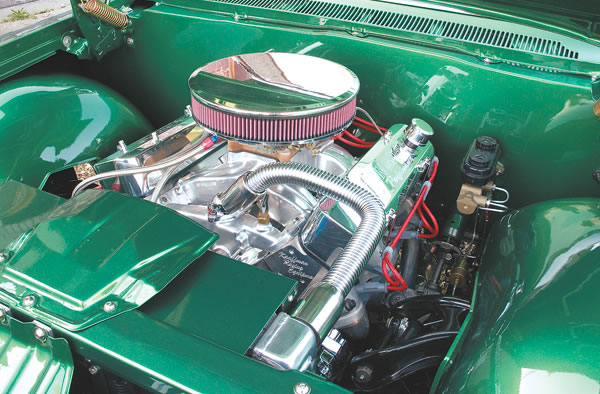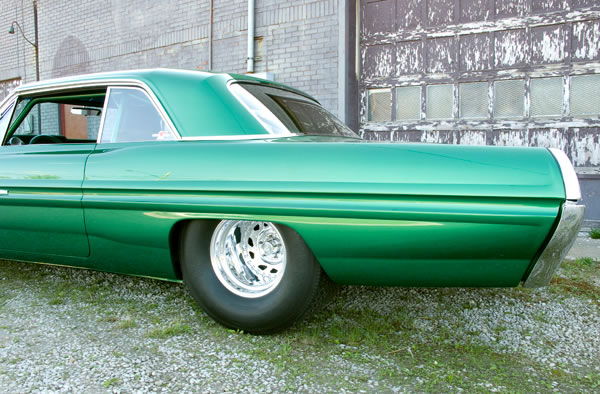Every time Ron Kintz looks at his 1962 Pontiac Grand Prix, he can’t help but smile.
After spending 10 years turning a scorched and melted scrap pile into this streamlined starship of a car, you’d think he’d be tired of seeing it. But for Ron, this car is a dream come true, and he made it happen with some sweat, some tears, and the help of his friends and family. The pride is plain to see even as he simply flicks on the headlights for the photographer. He ran those wires, installed that switch, polished that chrome trim around the lights by hand, and he did it all and more while keeping his business running and family growing.
It all started in 1996. Lanky Ron was at a swap meet with his friend Bill Brautigam when he spied a roughed-up ’62 Grand Prix on a trailer. Ron was a real Pontiac fan, having owned a Pro Street ’71 Firebird and a ’70 Catalina, and he really liked the big cars of the early 1960s.
“I just didn’t realize at the time that it was a Grand Prix,” Ron said. “I figured it was another Catalina and it might make a good Pro Street project for someone.”
Later, it dawned on Ron that he was that someone. He proceeded to kick himself.
Ron and Bill spent the next few weeks searching for another ’62, finally spotting one in the local classifieds. When they saw it, they realized it was the very same one from the swap meet!
“We took a better look at it this time and found that almost every panel was rusted or dented,” Ron said. “It had sat next to a building that caught fire, which melted wiring in the engine compartment and discolored some panels. The original 389 was on a stand next to it, but the transmission remained in it, held up with wire.”
Eventually, Ron talked the owner down to $1,300 and he hauled it over to Bill’s house (since his was the only garage large enough to accommodate the massive machine). There the Grand Prix remained for several years while Ron and Bill worked on it and Bill’s Henry J on weekends and evenings.
Ron called upon Jim Stallard of Stallard Performance in Akron, OH to take good care of the Grand Prix’s body, replacing rusted out areas with new sheetmetal, enlarging the rear wheel openings for bigger tires, smoothing the firewall, and modifying the interior metal. Jim also masterfully applied the PPG Electric Green paint job.
Ron and Bill took care of just about everything else, including major modifications for a back-half four-link kit, roll cage, wheel tubs, and a custom-fabricated floor, complete with transmission tunnel, raised even with the tops of the rockers to ensure room for the exhaust. Ron even bought a polishing kit and restored a lot of the stainless trim by hand himself.
For a while, the project was slowed while Ron’s family grew with the addition of a third child. He also bought a new house with a larger garage, so the Grand Prix could finally come home. Progress dragged until the spring of 2005.
“I spent the weekend at a car show without my car, and knew it had to be the last time,” Ron said. “The car had to be done by spring next year.”
Over the next year, like a man possessed, Ron finished the suspension, repainted the undercarriage, and reinstalled the glass and trim. He sold the stock 389, bought a 455 out of a 1970 B-body Pontiac from a local salvage yard, and took it to Kevin Swaney of Tin Indian Performance in Uniontown, OH. His performance upgrade included a .060-inch overbore, Ross forged aluminum pistons, CNC-ported cylinder heads from Kauffman Racing Equipment, Holley 850 cfm carburetor, and a Crower cam.
During the three-month engine upgrade, Ron pulled together the interior with the help of Marilynn Jarvis of Miracles Upholstery in Akron. Fiero seats, complete with headrest-mounted speakers, were reupholstered in green tweed and gray leather, and Marilynn also crafted the unique Indian-head door inserts and arrowhead rear deck cover.
It’s a good thing the Grand Prix is so cavernous—every show it visits, it’s loaded up with trophies for the ride home.
“Most guys never finish these projects,” Ron said. “I might have a tweak or two later, or maybe I’ll convert to fuel injection, but honestly, this car turned out exactly the way I wanted it. I just want to enjoy it from now on.”
FAST SPECS
Chassis
Frame: Chris Alston’s Chassisworks back-half four-link kit with 10-point roll cage; wheel tubs, and custom floor panels and driveshaft tunnel
Rear End: Ford 9-inch rear end, Moser axles, and Detroit Locker differential with 4.11 gears
Suspension: Monroe gas shocks with modified stock springs front; QA1 coilovers rear
Brakes: Wilwood 11 1/2-inch disc brakes with four-piston calipers (front), Strange 11 1/4-inch disc brakes (rear)
Wheels and Tires: Center Line Warrior wheels (15 x 4 1/2 front, 15 x 15 rear), Mickey Thompson Sportsman tires (26 x 7 1/2 front, 33 x 21 1/2 rear)
Engine and Transmission
Engine: Stock 455 from a 1970 Pontiac B-body with a performance rebuild: overbored to .060-inch, main and rod journals undersized by 0.010-inch forged aluminum Ross pistons, Total Seal rings, 6.625-inch forged-steel Eagle connecting rods, Federal-Mogul bearings
Engine Built By: Kevin Swaney at Tin Indian Performance in Uniontown
Induction/Valvetrain: Holley 4150 850 cfm carburetor, Edelbrock Torker II intake manifold, Kauffman Racing Equipment CNC-ported cylinder heads (2.11-inch/1.66-inch valves, K&N air filter, Crower hydraulic flat-tappet camshaft (246-degree/254-degree duration)
Exhaust: Hedman 1 3/4-inch Hedders, three-inch exhaust tubing with Pypes Performance X-type crossover, two Flowmaster 40 Series mufflers
Transmission: Turbo 400 transmission, TransGo shift kit, 3,200-stall torque converter from Continental Converters, B&M transmission-fluid cooler
Other: Mallory Comp 140 Series electric fuel pump, Summit 15-gallon aluminum fuel cell, Melling 60 psi oil pump
Body
Mods: Rear wheel wells enlarged two inches, shaved door handles, fiberglass hood with four-inch cowl scoop, and fiberglass deck lid
Paint Color: PPG Electric Green Metallic base (four coats), topped with three coats of PPG clear
Body Work By: Jim Stallard of Stallard Performance
Interior
Components: Auto Meter Sport Comp gauges, Fiero front seats with headrest speakers, Rex Marine steering wheel, Custom Autosound stereo, Precision Products ratchet shifter
Mods: removed heater controls, smoothed firewall, filled all unused holes in dash, restored stock speedometer, RJS belts
Upholstery: Green tweed and gray leather, with custom Indian profile inserts on the doors and arrowhead insert on rear deck
Upholstery By: Marilynn Jarvis of Miracles Upholstery in Akron, OH
Special Thanks To: Kara Kintz, Bill Brautigam











The ’62’s we’re always my favorite pontiac, since going to the races with arnie beswick.
Thats a nice Pro Street car, Lary: you know Arnie had a 61′ :=)
mike, yes, but i never liked it. it’s still sitting in a barn in polo,ill.
Our family car when I was growing up was a 1962 Pontiac Grand Prix. White with a candy apple red top. Growing up I never saw another one and I have not to this day. It was the coolest family car in town. And boy could my Mother drive it. We use to tell Mom, “pin us to the seats Mom”. She would kick in all three two barrels as she would slam through two or three gears and pin us kids to the seat for sure. Usually backing off at 100.
I sure wish I could find one. I really, really love yours. Is it for sale?
Beautiful job on your car. I had a 2 door 62 Catalina in 69 while in service. Let it go to my brother as I could not afford insurance and tag. It got tossed between him, dad and mom. Dad traded it for a 68 Olds. Wanted another one ever since. Found a 62 Catalina 4 door locally, bought it for $1500.00(a steal). Very good shape, just small(2″)rusted hole in left rear door, 2″ rusted hole in right front fender. Very minor rusted holes in front and rear floor boards and in trunk . Took about 2 hrs. to repair. Top part of engine disassembled and cleaned of old gunked up oil, reassembled and runs great. It’s a 389 with a 2 barrel Rochester carb. Engine runs great. All brake parts including wheel cylinders replaced with new master cylinder. Presently working on interior(attempting all new foam, upholstery, etc(to save $). Will do miner dent and crease repair and will paint the original color of Ensin Blue with a Cameo White top. Slow going from Jan 2020 from having heart failure and pacemaker instal. Two weeks ago had 3 stints put in three arteries. Doing well (better) now. Hopefully will have it at least road worthy by April 2025(probably unfinished interior and paint) but legally drivable.